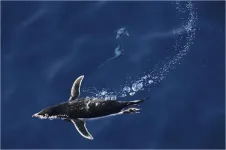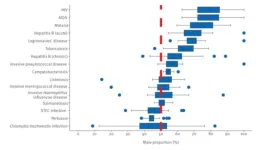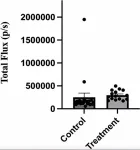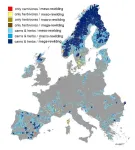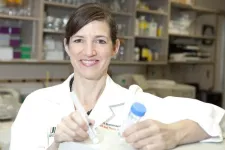(Press-News.org) A team of scientists led by the University of Colorado Boulder has identified 30 new areas critical for conserving biodiversity in the Southern Ocean surrounding Antarctica. In a study published Aug. 15 in the journal Conservation Biology, the researchers warn that without greater protection to limit human activities in these areas, native wildlife could face significant population declines.
“Many animals are only found in the Southern Ocean, and they all play an important role in its ecosystem,” said Cassandra Brooks, the paper’s senior author and associate professor in the Department of Environmental Studies and a fellow of the Institute of Arctic and Alpine Research at CU Boulder. “While Antarctica and the Southern Ocean feel really far away, they – and the life within them - are critical to the functioning of Earth systems,”
The Southern Ocean is home to many beloved animals like Adélie penguins, Weddell seals and humpback whales. Its remote location and harsh conditions—including frigid temperatures and extensive sea ice—have largely protected biodiversity in Antarctica and the Southern Ocean from human activities.
“Despite the planet being in the midst of a mass extinction, the Southern Ocean in Antarctica is one of the few places in the world that hasn’t had any known species go extinct,” said Sarah Becker, the paper’s first author and a doctoral student in the Department of Environmental Studies.
But as climate change warms the planet and melts the sea ice, fishing and tourism in the region have increased. These human activities not only compete with wildlife for resources but could also cause stress, and introduce invasive species and diseases that native wildlife has little or no defense mechanisms against.
Becker, Brooks and their team set off to identify Key Biodiversity Areas (KBAs) in the Southern Ocean that species depend on for their populations to persist.
They used existing tracking data for 13 Antarctic and sub-Antarctic seabirds and seals—for example Adélie penguins, sooty albatrosses and southern elephant seals— and identified 30 KBAs across the Southern Ocean. These sites represent marine habitats that species travel to for foraging, breeding and migration.
Prior work in identifying conservation zones in the Southern Ocean at a large scale tended to group different species into a single dataset to look for areas important for multiple species. While this approach is a vital component of conservation planning, it can overlook some areas crucial for certain species due to their unique life stages and migration patterns, Becker said.
For example, the team found two large sites in the waters near Amanda Bay in East Antarctica that serve as key foraging grounds for many emperor penguins as they recover after breeding. The researchers also identified several sites in the waters near Campbell Island South of New Zealand where a breeding population of endangered grey-headed albatross forage. Other similar large-scale conservation designation efforts, such as Important Bird Areas or Ecologically and Biologically Significant Areas, had not flagged these sites as priorities.
“Our study bridges the gap between the broad-scale perspective and the specific needs of individual populations, adding an important layer of detail,” Becker said.
The researchers hope international bodies and governments will consider these findings when developing conservation strategies and determining areas where fishing should be restricted.
“By reducing fishing or tourism interactions in these key biodiversity areas, we can potentially give these animals the best chance of adapting and becoming resilient to climate change,” said Brooks, who is also a fellow of CU Boulder’s Institute of Arctic and Alpine Research.
The Southern Ocean is one of the most pivotal buffers of climate change. Its cold water captures 40% of human-generated carbon dioxide emissions around the world and 60-90% of the excess heat from climate change.
“Antarctica is far away, but what happens there doesn’t stop there,” Brooks said. “Wildfires here in Colorado are tied to what's happening in the Southern Ocean. Through doing more to safeguard the Antarctic, we actually stand to create a more livable world for us all.”
END
As human activities expand in Antarctica, scientists identify crucial conservation sites
2024-08-15
ELSE PRESS RELEASES FROM THIS DATE:
Solutions to Nigeria’s newborn mortality rate might lie in existing innovations, finds review
2024-08-15
The review, led by Imperial College London’s Professor Hippolite Amadi, argues that Nigeria’s own discoveries and technological advancements of the past three decades have been “abandoned” by policymakers.
The authors argue that too many Nigerian newborns, clinically defined as infants in the first 28 days of life, die of causes that could have been prevented had policymakers adopted recent in-country scientific breakthroughs.
Led by Professor Amadi of Imperial’s Department of Bioengineering, who received the Nigeria Prize ...
Study highlights sex differences in notified infectious disease cases across Europe
2024-08-15
A study published in Eurosurveillance analysing 5.5 million cases of infectious diseases in the European Union/European Economic Area (EU/EEA) over 10 years has found important differences in the relative proportion of notified male versus female cases for several diseases. The proportion of males ranged on average from 40-45% for pertussis and Shiga toxin-producing Escherischia coli (STEC) infections to 75-80% for HIV/AIDS.
“Although this study was not able to fully explain the differences observed across countries and diseases, it offers some interesting leads,” said Julien Beauté, principal expert in general surveillance at the European ...
Nanobody inhibits metastasis of breast tumor cells to lung in mice
2024-08-15
“In the present study we describe the development of an inhibitory nanobody directed against an extracellular epitope present in the native V-ATPase c subunit.”
BUFFALO, NY- August 15, 2024 – A new research paper was published in Oncotarget's Volume 15 on August 14, 2024, entitled, “A nanobody against the V-ATPase c subunit inhibits metastasis of 4T1-12B breast tumor cells to lung in mice.”
The vacuolar H+-ATPase (V-ATPase) is an ATP-dependent proton pump that functions to control the pH of intracellular compartments ...
Detecting machine-generated text: An arms race with the advancements of large language models
2024-08-15
Machine-generated text has been fooling humans for the last four years. Since the release of GPT-2 in 2019, large language model (LLM) tools have gotten progressively better at crafting stories, news articles, student essays and more, to the point that humans are often unable to recognize when they are reading text produced by an algorithm. While these LLMs are being used to save time and even boost creativity in ideating and writing, their power can lead to misuse and harmful outcomes, which are already ...
Nearly 25% of European landscape could be rewilded
2024-08-15
Europe's abandoned farmlands could find new life through rewilding, a movement to restore ravaged landscapes to their wilderness before human intervention. A quarter of the European continent, 117 million hectares, is primed with rewilding opportunities, researchers report August 15 in the Cell Press journal Current Biology. They provide a roadmap for countries to meet the 2030 European Biodiversity Strategy's goals to protect 30% of land, with 10% of those areas strictly under conservation.
The team ...
Emergency departments could help reduce youth suicide risk
2024-08-15
A study of over 15,000 youth with self-inflicted injury treated in Emergency Departments (EDs) found that around 25 percent were seen in the ED within 90 days before or 90 days after injury, pointing to an opportunity for ED-based interventions, such as suicide risk screening, safety planning, and linkage to services. Nearly half of ED visits after the self-inflicted injury encounter were for mental health issues.
“Self-inflicted injury is an important predictor of suicide risk,” said Samaa Kemal, MD, MPH, emergency medicine physician at Ann & Robert H. Lurie ...
Uterus transplant in women with absolute uterine-factor infertility
2024-08-15
About The Study: Uterus transplant was technically feasible and was associated with a high live birth rate following successful graft survival. Adverse events were common, with medical and surgical risks affecting recipients as well as donors. Congenital abnormalities and developmental delays have not occurred to date in the live-born children.
Corresponding Author: To contact the corresponding author, Liza Johannesson, MD, PhD, email Liza.Johannesson@bswhealth.org.
To access the embargoed study: Visit our For The Media website at this link https://media.jamanetwork.com/
(doi:10.1001/jama.2024.11679)
Editor’s ...
Adverse childhood experiences and adult household firearm ownership
2024-08-15
About The Study: Consistent with prior research on adverse childhood experience (ACE; defined as abuse, neglect, and household dysfunction before age 18) exposure and presence of a firearm in the household during childhood, this study found that cumulative ACE exposure was associated with higher odds of household firearm ownership in adulthood. The relationship may be due to a heightened sense of vulnerability to physical violence and greater perceived threats to personal safety associated with a traumatic childhood, which lead individuals to seek self-protection.
Corresponding Author: To contact the corresponding author, Alexander Testa, PhD, email alexander.testa@uth.tmc.edu.
To ...
Warning signs: National data indicate that autistic birthing people are at increased risk for postpartum anxiety and depression
2024-08-15
American women have the highest rate of maternal deaths among high-income countries, with outcomes worse for minoritized groups. In an effort to understand the maternal health of pregnant people with intellectual and developmental disabilities, including autism and intellectual disability, researchers from Drexel University’s Policy and Analytics Center in the A.J. Drexel Autism Institute examined Medicaid data to identify perinatal and postpartum outcomes among people with intellectual and developmental disabilities. The study was recently published in JAMA Network Open.
“While ...
Can a mouthwash-based test help predict head and neck cancer recurrence?
2024-08-15
MIAMI, FLORIDA (EMBARGOED UNTIL AUG. 15, 2024 @ 11 A.M. EDT) – For years, mouthwash has been marketed as an essential hygiene item to prevent bad breath, even though it offers minimal if any health benefits.
But what if a mouthwash-based test to detect biomarkers can help physicians predict disease recurrence in head and neck cancer patients?
That futuristic scenario seems closer to reality after a new study by researchers at Sylvester Comprehensive Cancer Center at the University of Miami Miller School of Medicine, UC San Diego Health and collaborating cancer centers.
Their findings, ...
